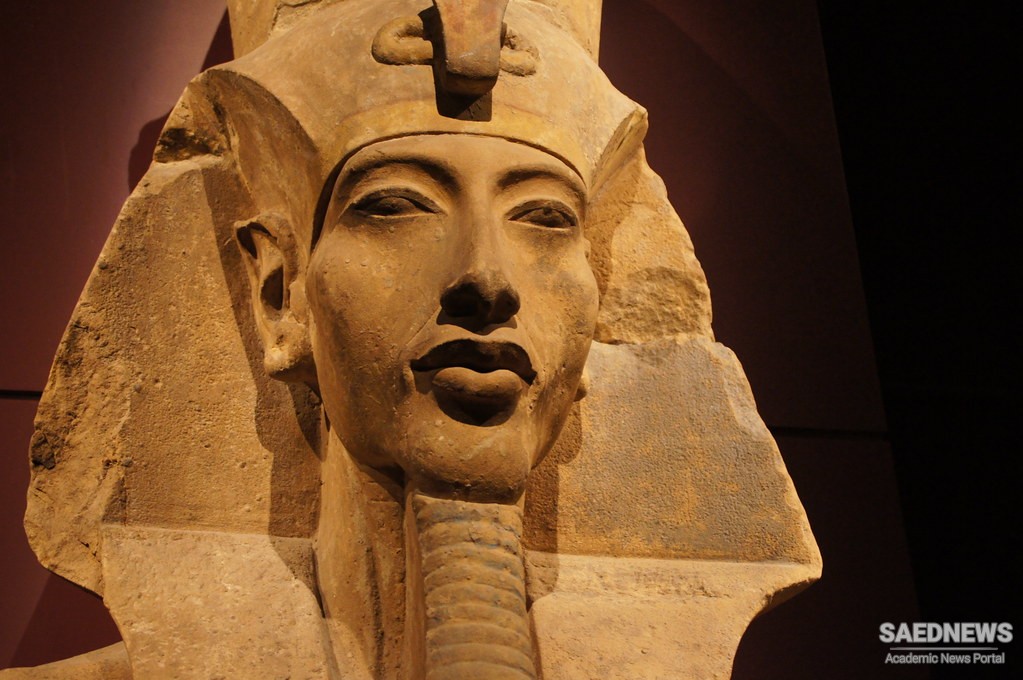There was under the Eighteenth Dynasty almost a renaissance of the arts, a transformation of military techniques by the adoption of Asiatic devices such as the chariot, and, above all, a huge consolidation of royal authority. It was then that a female, Hatshepsut, for the first time occupied the throne in a reign notable for the expansion of Egyptian commerce, or so her mortuary temple seems to show. The next century or so brought further imperial and military glory, with Hatshepsut’s consort and successor, Thotmes III , carrying the limits of Egyptian empire to the Euphrates.
Monuments recording the arrival of tribute and slaves, and marriages with Asiatic princesses testify to an Egyptian pre-eminence matched at home by a new richness of decoration in the temples and the appearance of a sculpture in the round, which produced busts and statues generally regarded as the peak of Egyptian artistic achievement. Foreign infl uences also touched Egyptian art at this time; they came from Crete.
Towards the end of the New Kingdom, the evidence of multiplied foreign contacts begins to show something else: the context of Egyptian power had already changed importantly. The crucial area was the Levant coast which even Thotmes IIIhad taken seventeen years to subdue. He had to leave unconquered a huge empire ruled by the Mitanni, a people who dominated eastern Syria and northern Mesopotamia. His successors changed tack.
A Mitanni princess married a pharaoh and to protect Egyptian interests in this area the New Kingdom came to rely on the friendship of her people. Egypt was being forced out of the isolation which had long protected her. But the Mitanni were under growing pressure from the Hittites to the north, one of the most important of the peoples whose ambitions and movements break up the world of the Middle East more and more in the second half of the second millennium BC.
We know a lot about the preoccupations of the New Kingdom at an early stage in this process because they are recorded in one of the earliest collections of diplomatic correspondence, for the reigns of Amenhotep III and IV( c . 1400 – 1362 BC ). Under the first of these kings, Egypt reached its peak of prestige and prosperity. It was the greatest era of Thebes. Amenhotep was fittingly buried there in a tomb which was the largest ever prepared for a king, though nothing of it remains but the fragments of the huge statues the Greeks later called the colossi of Memnon (a legendary hero, whom they supposed to be Ethiopian).
Amenhotep IV succeeded his father in 1379 BC. He attempted a religious revolution, the substitution of a monotheistic cult of the sun god Aton for the ancient religion. To mark his seriousness, he changed his name to Akhnaton and founded a new city at Amarna, 300 miles north of Thebes, where a temple with a roofless sanctuary open to the sun’s rays was the centre of the new religion. Although there can be no doubt of Akhnaton’s determination and personal piety, his attempt must have been doomed from the start, given the religious conservatism of Egypt, and there may have been political motives for his persistence.
Perhaps he was trying to recover power usurped by the priests of Amon-Re. Whatever the explanation, the opposition Akhnaton provoked by this religious revolution helped to cripple him on other fronts. Meanwhile, Hittite pressure was producing clear signs of strain in the Egyptian dependencies; Akhnaton could not save the Mitanni, who lost all their lands west of the Euphrates to the Hittites in 1372 and dissolved in civil war which foreshadowed their kingdom’s disappearance thirty years or so later. The Egyptian sphere was crumbling. There were other motives, perhaps, than religious outrage for the later exclusion of Akhnaton’s name from the offi cial list of kings.


 Nile Valley's Significance in Egyptian Civilization
Nile Valley's Significance in Egyptian Civilization














































